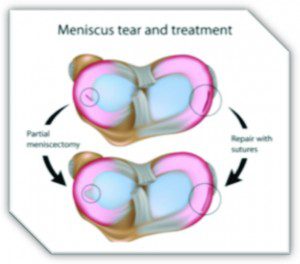By Daniel Milam, D.O., Orthopaedic Surgeon
 Meniscus Tear/Knee Injury Treatment
Meniscus Tear/Knee Injury Treatment
Recently, my six-year-old son has gotten into telling jokes. While some are reasonably funny, others take a little creativity on my part to belt out a laugh. The other day, however, he told me a pretty good one.
“What did the orthopedic surgeon say to the gingerbread man that hurt his knee?”
I knew where this was going, but I genuinely looked forward to hearing him tell me the punch line.
“Don’t know. What did he say to the gingerbread man that hurt his knee?”
“Did you try icing it?”
Not too shabby for a six-year-old. I’m pretty sure my wife helped him with that joke in particular. All kidding aside, this type of conservative approach has been a major part of my practice over the past nine years. I like to make sure my patients do “tried and true” moderate approaches like the RICE (Rest, Ice, Compression, Elevate) method for a large number of injuries before we jump into anything more complex.
A meniscus tear is a good example of an injury where I would first recommend a conservative approach. Unfortunately, this is a common injury that can cause tremendous pain and swelling in the knee. Depending on the severity of the injury, I encourage patients to use the RICE Method initially.
There are two types of meniscus tears, traumatic (acute) and degenerative (age-related). The most common of the two types of injuries is traumatic, so for all the exercise fanatics, weekend warriors or accident-prone patients out there, the RICE method, along with NSAID’s (aspirin or ibuprofen) should be your first line of defense if you believe you’ve torn your meniscus. Any time you or a loved one experiences a knee injury, you should consult a physician for a medical examination to evaluate how serious your tear might be. This can easily be determined by a physical exam, X-rays and/or an MRI.
What is the Meniscus?
The meniscus is a crescent shaped shock absorber, and we all have two in each knee, lateral and medial.
What’s unique about the meniscus is that only the outer portion of the tissue has a blood supply, while the inner portion receives nutrients intrinsically. What does this mean? Regrettably, it means that when you tear your meniscus, the primary reason it won’t heal on it’s own is because of the aforementioned distinctive blood supply.
The degenerative tears related to the aging process most often will respond better to conservative treatment approaches and monitoring. This is something that your orthopedic surgeon can discuss with you in more detail.
Symptoms, Diagnosis and Surgical Treatment
Swelling and pain in the knee are common symptoms of a meniscus tear and can be accompanied by sensations of clicking, locking, popping, catching, and occasionally even giving way.
After a thorough evaluation with appropriate images (X-ray/MRI), I discuss with my patients whether or not they need to have surgery. If surgery is necessary, it is almost always a minimally invasive arthroscopic procedure that can be done in our outpatient surgery center, so the patient would be able to go home the same day as their treatment.
The arthroscopic procedure for meniscus tears involves, trying to preserve as much of your meniscus tissue as possible. This is achieved by inserting a small camera through a tiny port in your knee, so that your surgeon can see inside and clearly visualize the area that needs to be addressed. Your surgeon will then be able to insert small instruments through the other port and perform your surgery with no major incisions, and very little, if any, disturbance to the surrounding tissue. Meniscus tears can be treated by suturing (stitching up the tear) and also by a meniscectomy, which requires cutting out the tear.
With the proper diagnosis, treatment, rehabilitation and home care most people can return to their pre-
injury range of motion and daily lifestyle activities within a few weeks or months depending on the severity of the injury.
Because meniscus tears are so common, if you feel that you have any of the symptoms mentioned above, please contact your physician or our office at your earliest convenience, as to not let the injury get any worse with continual wear and tear.
In homage to my son, if you injured your knee and you’re anything like the gingerbread man, always remember to put some icing on it first
Dr. Dan Milam
Born and raised in Bradenton, Florida, Dr. Milam is proud to be back serving his community. He is committed to building relationships with his patients, putting their needs first and providing a full explanation of their injury and all possible treatment options. Building these connections is as important to him as the expert medical care he provides.
To schedule an appointment for a consultation regarding your shoulder pain or other orthopedic issues, please contact our office at (941) 955-1231.







